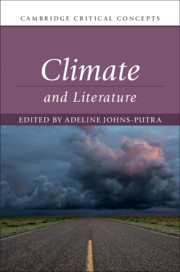Book contents
- Climate and Literature
- Cambridge Critical Concepts
- Climate and Literature
- Copyright page
- Contents
- Illustrations
- Contributors
- Acknowledgements
- Introduction
- Part I Origins
- Part II Evolution
- Chapter 7 Weather and Climate in the Age of Enlightenment
- Chapter 8 British Romanticism and the Global Climate
- Chapter 9 The Literary Politics of Transatlantic Climates
- Chapter 10 Climate and Race in the Age of Empire
- Chapter 11 Ethereal Women: Climate and Gender from Realism to the Modernist Novel
- Chapter 12 Planetary Climates: Terraforming in Science Fiction
- Chapter 13 The Mountains and Death: Revelations of Climate and Land in Nordic Noir
- Part III Application
- Bibliography
- Index
Chapter 12 - Planetary Climates: Terraforming in Science Fiction
from Part II - Evolution
Published online by Cambridge University Press: 31 July 2019
- Climate and Literature
- Cambridge Critical Concepts
- Climate and Literature
- Copyright page
- Contents
- Illustrations
- Contributors
- Acknowledgements
- Introduction
- Part I Origins
- Part II Evolution
- Chapter 7 Weather and Climate in the Age of Enlightenment
- Chapter 8 British Romanticism and the Global Climate
- Chapter 9 The Literary Politics of Transatlantic Climates
- Chapter 10 Climate and Race in the Age of Empire
- Chapter 11 Ethereal Women: Climate and Gender from Realism to the Modernist Novel
- Chapter 12 Planetary Climates: Terraforming in Science Fiction
- Chapter 13 The Mountains and Death: Revelations of Climate and Land in Nordic Noir
- Part III Application
- Bibliography
- Index
Summary
This chapter examines ecological science fiction’s (sf) use of terraforming to critique technological climate control as a form of colonial mastery. Terraforming - the adaptation of planetary environments to make them habitable by forms of life from Earth - has long been an important figure in sf and has recently become crucial to its engagement with the climate and climate change. Terraforming narratives portray the complex interpenetrations between the climate, society, culture, science, and politics, and explore how systematic climate control functions as a way to control society and non-human nature. Analysing terraforming in three narratives that have been influential in shaping the motif, Arthur C. Clarke’s The Sands of Mars (1951), Frank Herbert’s Dune (1965), and Kim Stanley Robinson’s Mars trilogy (1992, 1993, 1996), this chapter shows how they highlight the persistence of colonial frontier narratives in shaping representations of interplanetary colonisation, thus connecting terraforming to a tradition of totalising technological mastery over the environment.
Keywords
- Type
- Chapter
- Information
- Climate and Literature , pp. 196 - 211Publisher: Cambridge University PressPrint publication year: 2019

